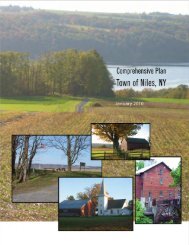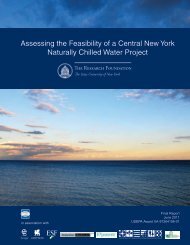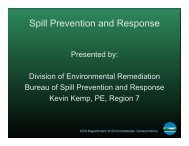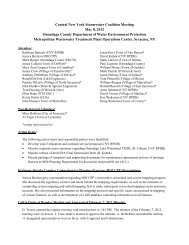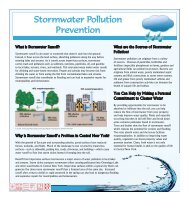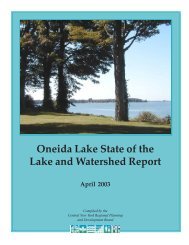A Management Strategy for Oneida Lake and its ... - CNY RPDB Home
A Management Strategy for Oneida Lake and its ... - CNY RPDB Home
A Management Strategy for Oneida Lake and its ... - CNY RPDB Home
Create successful ePaper yourself
Turn your PDF publications into a flip-book with our unique Google optimized e-Paper software.
fluctuations in flow <strong>and</strong> water levels (in the<br />
past) that early settlers learned to live with.<br />
“We” then decided that we were going to use<br />
this resource to fit our needs (transportation,<br />
drinking water, waste-water assimilation,<br />
recreation, <strong>and</strong> so on). The control we imposed<br />
upon the waters of the basin; regulating<br />
the highs <strong>and</strong> lows of water levels <strong>and</strong> the<br />
flow within this system lead us to believe it<br />
was safer to live closer to the waters edge.<br />
Somewhere along this path of getting closer to<br />
the water we love, we <strong>for</strong>got that we don’t<br />
have control over the weather <strong>and</strong> the resulting<br />
river flows <strong>and</strong> lake levels. During extreme<br />
conditions (too much water or too little)<br />
we’re just spectators to the whims of Mother<br />
Nature <strong>and</strong> hope <strong>for</strong> the best.<br />
As such, the specter of “control” leads to the<br />
assumption that we can, <strong>and</strong> do control the<br />
water resource system (at all times) to meet<br />
our diverse needs. The term control leads to<br />
several assumptions that get us to the heart of<br />
the riverside <strong>and</strong> lakeshore homeowners<br />
concerns:<br />
1. Once a population feels that the water<br />
level is “under control” they move to the<br />
waters’ edge feeling that there will not be<br />
any problem (The Mt. Olympus mode of<br />
thinking -- “everything is perfect, all the<br />
time”). The fact that living on a water<br />
body makes one feel better is another matter<br />
-- as long as the water stays where it is<br />
supposed to stay.<br />
2. <strong>Oneida</strong> <strong>Lake</strong> levels <strong>and</strong> flows have been<br />
“controlled” <strong>for</strong> over a century <strong>and</strong> within<br />
that time there were floods <strong>and</strong> droughts,<br />
but now people feel that flooding <strong>and</strong><br />
lower water periods have become more<br />
prevalent. Whether this ‘fact’ is due to our<br />
continued utilization <strong>and</strong> harnessing of a<br />
natural system, to changes in our climate<br />
<strong>and</strong> weather patterns, or due to an entity<br />
(The Canal Corp) “not doing <strong>its</strong>’ job”, is<br />
constantly being debated, but our society<br />
has moved from assuming personal responsibility<br />
to finding someone to blame.<br />
We need to return to assessing the situation<br />
<strong>and</strong> learning what we can do <strong>and</strong> cannot<br />
do (individually <strong>and</strong> as a group) to reduce<br />
the damages to our property <strong>and</strong> livelihood.<br />
3. The population that lives ‘on the lake or<br />
along the river’ has dramatically increased<br />
-- from seasonal cabins to year-round<br />
homes; from homes near the lake/river to<br />
homes on the lake/river, <strong>and</strong> the increase<br />
in the number of homes has been dramatic.<br />
All of these actions put our dwellings into<br />
a zone that is affected to a greater degree<br />
by river/lake-level changes (even small<br />
ones). These homes also impact water<br />
quality due to the location of their septic<br />
systems <strong>and</strong> manicured lawns adjacent to<br />
the water body (but that’s another story).<br />
4. People tend to <strong>for</strong>get that the lake (<strong>its</strong><br />
ecology, <strong>its</strong> water level, <strong>its</strong> water quality)<br />
does not remain static. The life cycle of a<br />
lake is one of growth to ultimate demise<br />
(albeit this process occurs over many of<br />
our life times, although we do have a way<br />
of speeding up the process)! A lake naturally<br />
becomes more productive (eutrophic),<br />
filling with sediment, <strong>and</strong> changing<br />
<strong>its</strong> ecology along the way. Man has altered<br />
these processes to the point that people<br />
don’t like what they see <strong>and</strong> there<strong>for</strong>e<br />
someone (else) has to be responsible <strong>for</strong><br />
the change.<br />
5. The control of water levels in a managed<br />
water-resource system is probably 95 percent<br />
or more efficient (or non threatening),<br />
but the remaining 5 percent is responsible<br />
<strong>for</strong> 100 percent of the heartburn we have<br />
when we find that we really can’t control<br />
the water resource <strong>for</strong> that 5 percent of the<br />
time.<br />
6. The presentation by Howard Gobel (Canal<br />
Corp.) during one of the last water-levelmanagement<br />
meeting highlighted the wa-<br />
page 96<br />
Appendices



